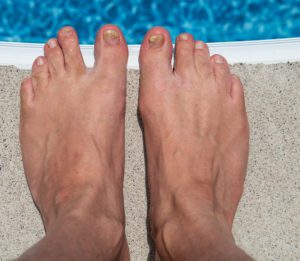

Nail fungus also referred to as onychomycosis is an infection underneath the surface of the nail cause by fungi or yeast. When the fungi take hold, the nail becomes darker, debris can collect under the nail, and white discoloration may appear. Overtime, the affected nails become very thick and difficult to trim. The fungus can even spread to adjacent nails.
You may have been exposed to the fungi when walking around damp areas barefoot like swimming pools, locker rooms, and showers. Injury to the nail bed, even pressure from shoes, will make it more susceptible to the fungi. Anyone can be affected but people with chronic diseases, such as diabetes, circulatory problems, or immune-deficiency conditions, are especially prone to developing a fungal nail infection. Other contributing factors may be a history of athlete’s foot and excessive perspiration.
Treatment can take months to a year to completely clear the fungus. Your healthcare provider will discuss treatments options with you to determine what is the best option for you. Unfortunately, recurrence is common. For these reasons, prevention is key.
Proper hygiene and performing daily foot exams including your toes are the first line of defense. Clean and dry feet can better resist infection by the fungus.
. Never go barefoot.
. Wear flip flops or shower shoes in public areas. For example, at public showers at the pool or gym. Walking around a public pool.
. Wash your feet with soap and water daily. Make sure to thoroughly dry your feet after washing, including between your toes. You may even want to wash your feet after the gym or going to a
public pool.
. Disinfect you shoes with an OTC antifungal sprays or powder’s.
. Wear moisture wicking and breathable socks. Socks made of synthetic fibers that wick moisture away from your feet are recommended. If your feet perspire than you should change your socks throughout the day. Don’t share shoes or socks with others. Change your socks after exercise. You may also alternate gym shoes to allow the material to dry completely.
. Don’t share clippers or foot products with other people. Disinfect instruments use to cut your nails and other pedicure tools.
. Treat athletes foot if present.
. Avoid tight fitting shoes and use shoes made with breathable material.
. If signs of nail fungus are present, avoid nail polish.
. Keep nails trimmed and clean. Nails should be at the same length as the tip of the toe.
. Wash your shoes, this includes hiking boots to sandals. Shoes that haven’t been cleaned are a great place for fungus to thrive.
For more information about preventing or treating nail fungus contact your local foot and ankle specialist.
Isin Mustafa
DPM, MSHS, AACFAS
For more information, you may contact Dr. Isin Mustafa at Family Foot & Leg Center at (833) 366-8534. Family Foot & Leg Center has 8 locations throughout Collier, Lee, & Charlotte Counties to quickly resolve all your foot and ankle problesm.
Family Foot and Leg Center
(833) 366-8534 (FOOT LEG)
www.NaplesPodiatrist.com
3161 Harbor Blvd, Suite B, Port Charlotte, FL 33952
 Southwest Florida's Health and Wellness Magazine Health and Wellness Articles
Southwest Florida's Health and Wellness Magazine Health and Wellness Articles

